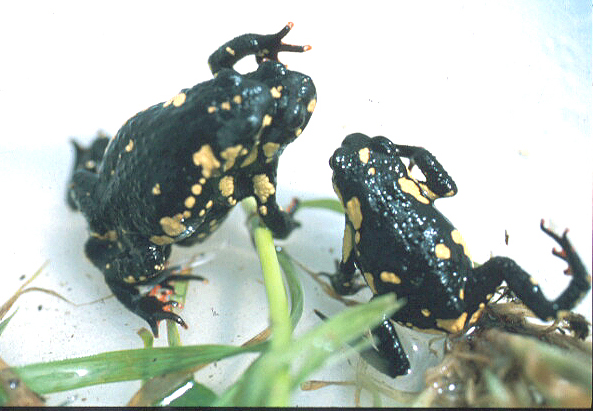Melanophryniscus Stelzneri on:
[Wikipedia]
[Google]
[Amazon]
''Melanophryniscus stelzneri'', commonly known as the redbelly toad, bumble bee toad or yellow and black walking toad, is a species of

toad
Toad is a common name for certain frogs, especially of the family Bufonidae, that are characterized by dry, leathery skin, short legs, and large bumps covering the parotoid glands.
A distinction between frogs and toads is not made in scientif ...
in the family Bufonidae {{Cat main, Toad
This category contains both species commonly called toads, and the true toads from the family Bufonidae {{Cat main, Toad
This category contains both species commonly called toads, and the true toads from the family Bufonidae {{Cat m ...
which is endemic
Endemism is the state of a species being found in a single defined geographic location, such as an island, state, nation, country or other defined zone; organisms that are indigenous to a place are not endemic to it if they are also found elsew ...
to Argentina
Argentina (), officially the Argentine Republic ( es, link=no, República Argentina), is a country in the southern half of South America. Argentina covers an area of , making it the second-largest country in South America after Brazil, th ...
. It is present in the pet trade
Wildlife trade refers to the of products that are derived from non-domesticated animals or plants usually extracted from their natural environment or raised under controlled conditions. It can involve the trade of living or dead individuals, ti ...
.
Etymology
The specific name ''stelzneri'' honorsAlfred Wilhelm Stelzner
Alfred Wilhelm Stelzner (20 December 1840, Dresden – 25 February 1895, Wiesbaden) was a German geologist.
From 1859 to 1864 he was a student at the Bergakademie Freiberg, an institute where he later served as inspector. From 1871 to 1874 h ...
, a German geologist who spent some time in Argentina.
Taxonomy and subspecies
''Melanophryniscus stelzneri'' was originally described in 1875. Currently twosubspecies
In biological classification, subspecies is a rank below species, used for populations that live in different areas and vary in size, shape, or other physical characteristics (morphology), but that can successfully interbreed. Not all species ...
are recognized: ''Melanophryniscus stelzneri stelzneri '' and ''Melanophryniscus stelzneri spegazzinii'' Gallardo, 1961. Other former subspecies are now considered full species, namely '' Melanophryniscus dorsalis'' and '' Melanophryniscus fulvoguttatus''.
Description
''Melanophryniscus stelzneri'' grows to about , with females typically being larger than males.
Distribution andhabitat
They were first discovered inCórdoba, Argentina
Córdoba () is a city in central Argentina, in the foothills of the Punilla Valley, Sierras Chicas on the Primero River, Suquía River, about northwest of Buenos Aires. It is the capital of Córdoba Province, Argentina, Córdoba Province a ...
. They are currently known from the Córdoba, San Luis, and Salta Province
Salta () is a province of Argentina, located in the northwest of the country. Neighboring provinces are from the east clockwise Formosa, Chaco, Santiago del Estero, Tucumán and Catamarca. It also surrounds Jujuy. To the north it borders Boliv ...
s of Argentina. Their range may also extend into Bolivia
, image_flag = Bandera de Bolivia (Estado).svg
, flag_alt = Horizontal tricolor (red, yellow, and green from top to bottom) with the coat of arms of Bolivia in the center
, flag_alt2 = 7 × 7 square p ...
. They occur in grasslands with rocky outcrops. Reproduction takes place in shallow ponds, streams, bogs, and even roadside ditches.
Diet and toxicity
''Melanphryniscus'' are toxic in the wild. Their natural diet is made up of mites and ants. It is believed that the toxins are created from alkaloids found in their natural diet. The brightly colored pattern is an example ofaposematism
Aposematism is the advertising by an animal to potential predators that it is not worth attacking or eating. This unprofitability may consist of any defences which make the prey difficult to kill and eat, such as toxicity, venom, foul taste or ...
. In captivity, they become non-toxic.
Notes
References
{{Taxonbar, from=Q2710906 stelzneri Endemic fauna of Argentina Amphibians of Argentina Amphibians described in 1875 Taxonomy articles created by Polbot